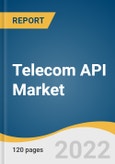The global telecom API market was valued at USD 827.45 billion in 2030 and is estimated to expand at a CAGR of 21.3% from 2023 to 2030. Growing demand for smartphones integrated with features such as GPS services, digital wallets, 5G, and Near-Field Communication (NFC), among others, is estimated to drive the market growth in the forecast period. Application programming interface (API) facilitates web-based solution developers to develop applications through a single point of contact using the capabilities offered by the application programming interface (API) platform for agile application development.
The increasing adoption of the Internet of Things (IoT) in the telecommunication sector is anticipated to sustain market growth over the forecast period. CSPs such as Orange, Verizon, AT&T, Inc., Google LLP, and others are providing their IoT API platforms to various sectors such as transportation, retail, utilities, and manufacturing among others. AT&T has an API marketplace to help solution providers quickly build web-based collaboration apps for their text, video, voice, and other communications services. The IoT platform developed by Orange namely Live Objects forms connections centrally through a web portal and standard API.
Web Real-Time Communication (WebRTC) API is a compilation of various standard APIs and protocols that handle simultaneously facilitate data sharing and peer-to-peer teleconferencing eliminating the necessity for installing any additional third-party plug-ins. The Telecom API market is expected to witness significant growth owing to the rising adoption of WebRTC by various Communication Service Providers (CSPs) and technology providers such as AT&T Intellectual Property, Huawei Technologies Co., Ltd., Vodafone Group, Orange, Cisco Systems, Inc., and Google among others. However, stringent government regulations for end-user data protection are expected to act as an inhibitor to market growth over the forecast period.
Since the disruption of COVID-19, major players are concentrated on solidifying their presence in the telecom API market by implementing strategies such as geographical expansion, mergers & acquisitions, new product developments, and partnerships. For instance, in March 2022, SignalWire, U.S.-based T-Mobile Ventures invested in a telecom API development startup, which develops video, voice, and messaging APIs, for advancement in 5G and API technology, among others.
The increasing adoption of the Internet of Things (IoT) in the telecommunication sector is anticipated to sustain market growth over the forecast period. CSPs such as Orange, Verizon, AT&T, Inc., Google LLP, and others are providing their IoT API platforms to various sectors such as transportation, retail, utilities, and manufacturing among others. AT&T has an API marketplace to help solution providers quickly build web-based collaboration apps for their text, video, voice, and other communications services. The IoT platform developed by Orange namely Live Objects forms connections centrally through a web portal and standard API.
Web Real-Time Communication (WebRTC) API is a compilation of various standard APIs and protocols that handle simultaneously facilitate data sharing and peer-to-peer teleconferencing eliminating the necessity for installing any additional third-party plug-ins. The Telecom API market is expected to witness significant growth owing to the rising adoption of WebRTC by various Communication Service Providers (CSPs) and technology providers such as AT&T Intellectual Property, Huawei Technologies Co., Ltd., Vodafone Group, Orange, Cisco Systems, Inc., and Google among others. However, stringent government regulations for end-user data protection are expected to act as an inhibitor to market growth over the forecast period.
Since the disruption of COVID-19, major players are concentrated on solidifying their presence in the telecom API market by implementing strategies such as geographical expansion, mergers & acquisitions, new product developments, and partnerships. For instance, in March 2022, SignalWire, U.S.-based T-Mobile Ventures invested in a telecom API development startup, which develops video, voice, and messaging APIs, for advancement in 5G and API technology, among others.
Telecom API Market Report Highlights
- The messaging API segment of the telecom API market is predicted to account for the largest market share in 2022 and is expected to expand at a CAGR of 21.4% in the forecast period. This growth is attributed to the increasing adoption of A2P messaging by large organizations for applications such as product announcements, and promotional activities among others.
- The partner developer segment is estimated to expand at the fastest CAGR of over 22.0% in the forecast period. Thus, growth can be attributed to the rising number of internet users and increasing adoption of over-the-top (OTT) media services by organizations.
- Asia Pacific held a maximum revenue share of over 28% in 2022 and is projected to witness a healthy CAGR in the forecast period. This growth is owing to the increasing number of smartphone users in countries such as India and China.
- The telecom API market is fragmented and characterized by high competition with the presence of major global players such as among others. These companies are adopting various organic and inorganic growth strategies such as collaborations, mergers & acquisitions to increase their market presence and expand their existing product portfolio.
Table of Contents
Chapter 1. Methodology and Scope
Chapter 2. Executive Summary
Chapter 3. Telecom API Market Variables, Trends & Scope
Chapter 4. Telecom API Market Type Outlook
Chapter 5. Telecom API Market End-User Outlook
Chapter 6. Telecom API Market: Regional Outlook
Chapter 7. Competitive Landscape
List of Tables
List of Figures
Companies Mentioned
- AT&T Intellectual Property
- Globe Labs
- Huawei Technologies Co., Ltd.
- LocationSmart
- Orange
- TWILIO INC.
- Verizon
- Vonage Holdings Corp.
- Vodafone Group
Methodology

LOADING...
Table Information
| Report Attribute | Details |
|---|---|
| No. of Pages | 120 |
| Published | December 2022 |
| Forecast Period | 2023 - 2030 |
| Estimated Market Value ( USD | $ 214.64 Billion |
| Forecasted Market Value ( USD | $ 827.45 Billion |
| Compound Annual Growth Rate | 21.3% |
| Regions Covered | Global |
| No. of Companies Mentioned | 10 |









